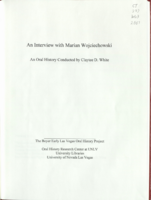Search the Special Collections and Archives Portal
Search Results
Pat Jones Photograph Collection
Identifier
Abstract
The Pat Jones Photograph Collection (approximately 1925-1930) consists of black-and-white photographic prints and slides of Harry Suiter in Rhyolite, Nevada. There are images of Suiter standing in front of abandoned buildings, as well as scenery near Rhyolite. Also included is an image of a wagon transport containing borax in Death Valley, California.
Archival Collection
First Methodist Church of Las Vegas Photograph Collection
Identifier
Abstract
The First Methodist Church Photograph Collection (approximately 1909-1912) contains black-and-white photographic prints and corresponding negatives of the Las Vegas train depot, railroad yards, and the First Methodist Church in Las Vegas, Nevada. Also included are portraits of Reverend Edwin A. Palmer and his family.
Archival Collection
Edward Joseph Deck Photograph Collection
Identifier
Abstract
The Edward Joseph Deck Photograph Collection (approximately 1870-1920) consists of photographic prints and negatives of Edward Joseph Deck and other miners in Pioche, Nevada and various locations around the townsite. There are also images of ranches, mills, and mill workers both in and outside of the Pioche townsite.
Archival Collection
Nino Maurizi Photograph Collection
Identifier
Abstract
The Nino Maurizi Photograph Collection consists of two black-and-white photographic prints and corresponding negatives of Nino Maurizi at the Mount Charleston Camp for the Las Vegas Army Air Field in 1943. Images depict Maurizi standing at the entrance of Mount Charleston Camp as well as inside the camp.
Archival Collection
Esther Ruth Peaslee Postcard Collection
Identifier
Abstract
The Esther Ruth Peaslee Postcard Collection (approximately 1900-1983) consists of postcards and postcard reproductions depicting a Labor Day celebration in Goldfield, Nevada, the Angelus Hotel, and the Goldfield Hotel. The reproductions were made approximately between 1960 and 1983. Also included is a postcard showcasing scenes in Goldfield.
Archival Collection
Stuart A. McCarthy Photograph Collection
Identifier
Abstract
The Stuart A. McCarthy Photograph Collection (approximately 1940-1949) consists of photographic prints and negatives of the Photo Mart storefront on Fremont Street as well as a view of the Golden Nugget, Eldorado Club, Hotel Apache, Boulder Club, and the Pioneer Club on Fremont Street in Las Vegas, Nevada.
Archival Collection
David Farnsworth Photograph Collection
Identifier
Abstract
The David Farnsworth Photograph Collection, approximately 1900 to 1915, contains five black-and-white photographic prints and corresponding negatives of David Farnsworth with groups of people posing outside storefronts in Las Vegas and Caliente, Nevada.
Archival Collection

Transcript of interview with Irene Doty by Jackie Ogden, March 20, 1977
Date
Archival Collection
Description
On March 20, 1977, Jackie Ogden interviewed Irene Doty (born 1914 in Dangerfield, Texas) about her life in Southern Nevada. Doty first talks about the first casino properties and restaurants in Las Vegas along with some of the other businesses and operations of the area. She also describes some of her experiences as a justice of the peace, conditions during World War II, and the clothing fashion of the time. Doty also talks about some of her experiences in Goodsprings, Nevada, and about her experiences as a juror and potential juror in several murder trials. The interview concludes with a discussion on housing development and gambling in Las Vegas.
Text

Transcript of interview with Marian Wojciechowski by Claytee White, June 16, 2009
Date
Archival Collection
Description
At age 95, Marian Wojciechowski recalls his personal story of being born a region called called Poland in 1914, just as World War I was beginning. This narrative gives special attention to his Polish background at a time when the country did not technically exist, and their language was forbidden. By the late 1930s and the dawning of World War II, Marian is a young man struggling to understand what is transpiring, but knowing that he must participate in the Polish underground resistance against the Germans His activism gets him arrested and sentenced to Auschwitz as a non-Jew and without penalty of death. He recalls the Gestapo beatings which have left him without feeling in his fingers and a loss of hearing. He shares historical perspectives of the war era, agricultural coops, goal of Germans to sell Jews to the United States and other countries, and a story about a woman who helped save 2500 Jewish children during war.
Text
